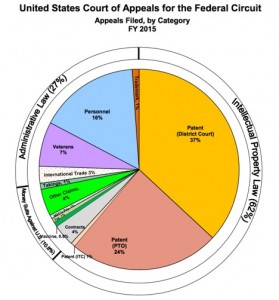With the advent of the America Invents Act there has been a growth in appeals from the PTAB to the Federal Circuit. Appeals from the USPTO constituted 24% of the court’s workload in Fiscal Year 2015 — compared to a mere 9% in Fiscal Year 2013! I believe an unintended consequence of the AIA will be not only a growth in workload from the appeals of post-grant proceedings but also a growth in workload from appeals of the PTAB’s ex parte matters. As attorneys become more accustomed to appealing PTAB post-grant decisions, it is only natural that those attorneys will be more likely to apply their skills to appeal a much greater number of ex parte matters than the Federal Circuit has been accustomed to. The growth in workload is already reflected by the apparent increase in Rule 36 Judgments and the growth in the ranks of the USPTO’s Solicitor’s office.
I suppose one way to address this growing workload is to expand the CAFC to include more judges. But, does it make sense to add more judges to an already large and frequently fractured court? Would it make more sense to focus the CAFC on intellectual property matters and split off a section of the court as a new court to focus on the other subject areas of the court’s docket? Obviously, it’s debatable.
If one were to split the court, what would the two divisions look like? One starting point is to see how the judges break out by technical/non-technical background. It makes sense to keep the non-senior judges having technical backgrounds or district court judicial experience as the ones adjudicating the IP (primarily patent) appeals. Such a group would include judges Newman, Lourie, Moore (Chief Judge), O’Malley, Wallach, Taranto, Chen, and Stoll. The other court would consequently be assigned judges Prost (Chief Judge), Dyk, Reyna, and Hughes. So far, that ratio (8:4) looks appropriate given that the court’s patent, trademark, and ITC docket in 2015 constituted 63% of the court’s total docket. I do think Judge Reyna has brought a fresh perspective to the CAFC’s jurisprudence. It might be worthwhile to swap his expertise with that of Judge Lourie, as a new court would benefit from someone like Judge Lourie with such a great sense of humor. It would be a tough call, though, because both Judge Reyna and Judge Wallach have immense international trade law experience and would provide considerable value to the new court. That leaves only a few senior judges to assign. As a former chief judge, Judge Mayer would provide valuable experience to a new court — plus, he does not seem to be a real fan of oral arguments; so, the new court with its merit cases and limited number of oral arguments would be a good fit for him. As a former assistant US Solicitor General, Judge Bryson would also be a good fit for the new court. Judges Plager, Clevenger, and Schall have a wealth of patent law experience; so, it would make sense to include them in the IP group. Additional positions could be filled on each court by new appointees as workload demands.
At the end of the day, one embodiment of the court split would be the following:
Reconfigured Federal Circuit………………………………. New Court
C.J. Moore C.J. Prost
Newman Mayer
Plager Lourie
Clevenger Bryson
Schall Dyk
Linn Hughes
O’Malley
Reyna
Wallach
Taranto
Chen
Stoll
By pure coincidence, I suspect that this partitioning would have a dramatic effect on reducing the current fractures among the court, e.g., with respect to 35 U.S.C. §101 issues. Pure coincidence.
